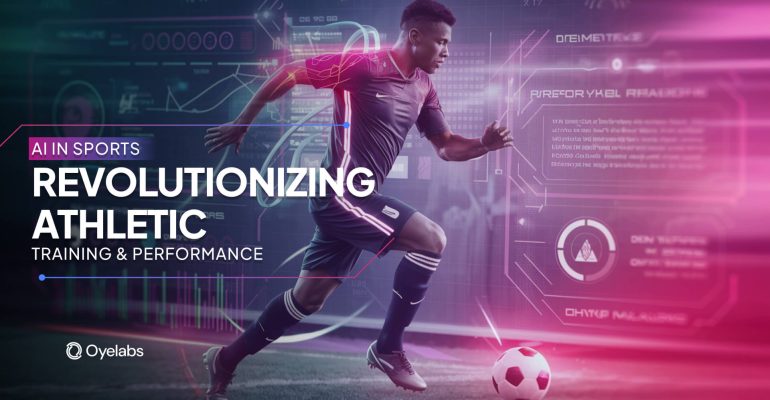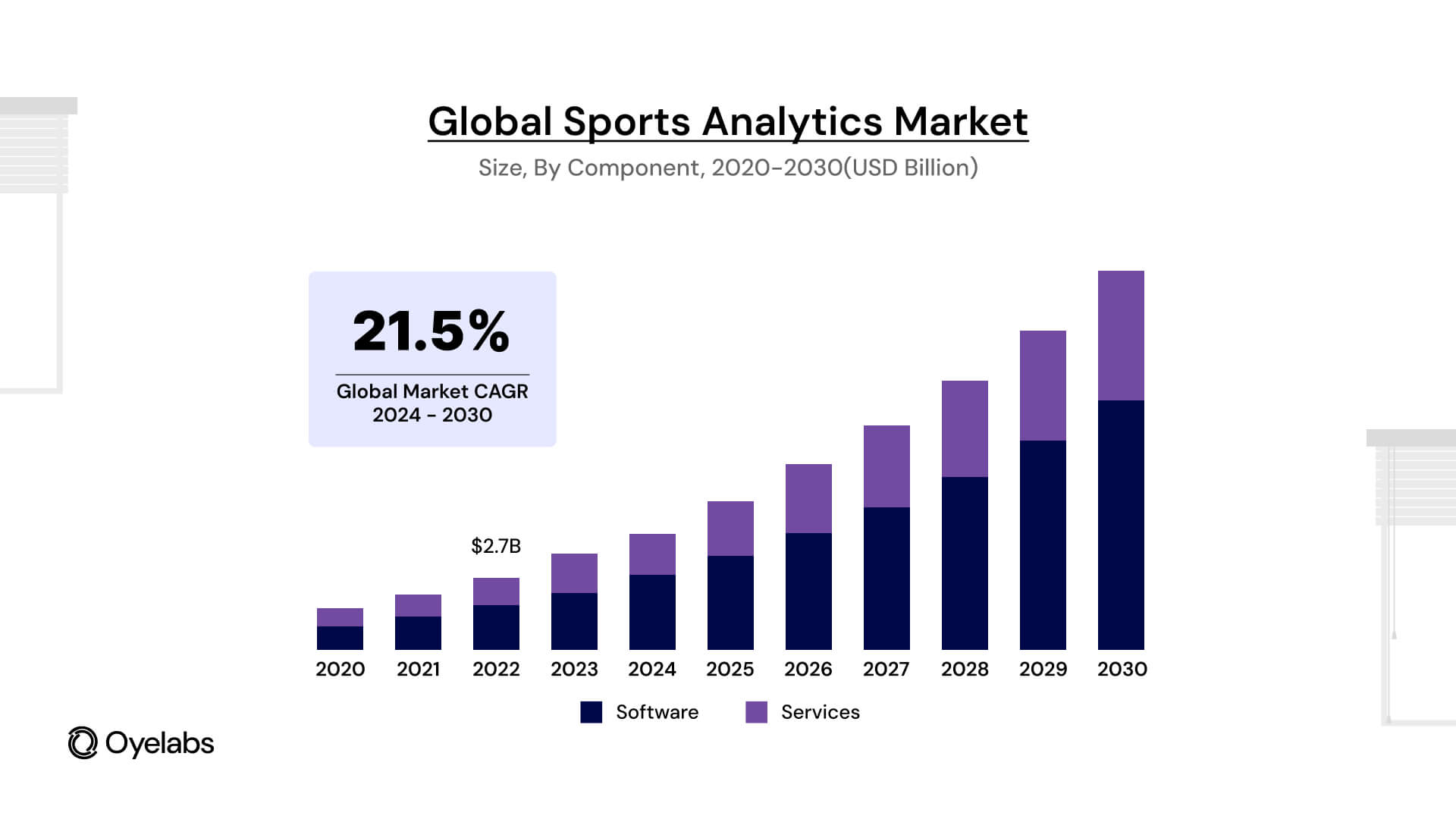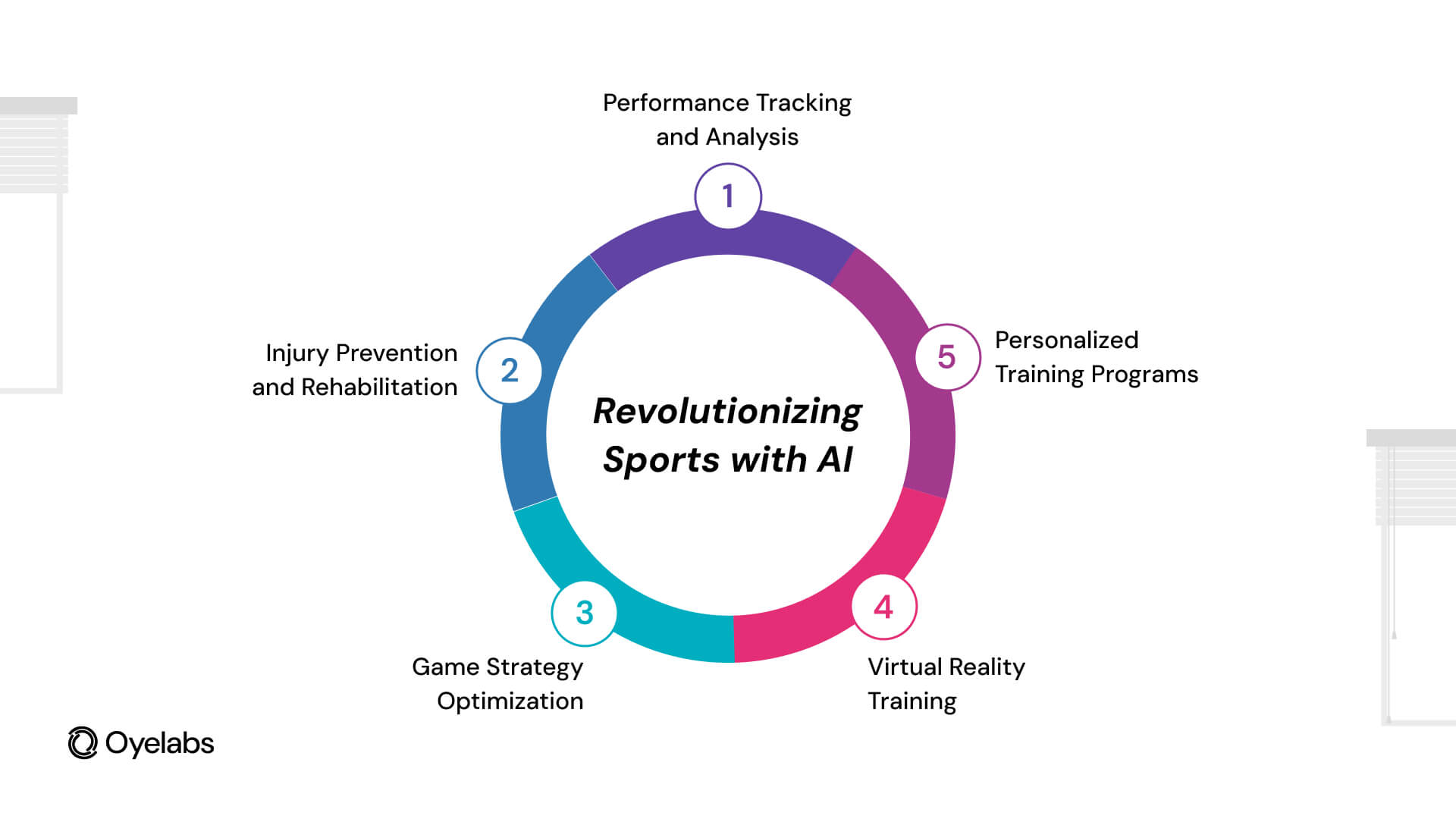AI in Sports: Revolutionizing Athletic Training and Performance

AI in Sports: Revolutionizing Athletic Training and Performance
Last Updated on July 11, 2025
AI has already taken over numerous industries, so why should sports be left behind? From healthcare to entertainment, technology has transformed nearly every field, and now it’s sports’ turn to harness the power of AI. Athletes and coaches are tapping into AI-driven tools to enhance performance, improve training efficiency, and even prevent injuries. With AI analyzing data in real time, athletes are getting tailored insights that help them push boundaries and achieve peak performance. This surge in AI adoption is reflected in market growth. The artificial intelligence in sports market was valued at $2.2 billion in 2022 and is projected to reach $29.7 billion by 2032, growing at a CAGR of 30.1% from 2023 to 2032. If AI can revolutionize so many other sectors, it’s only a matter of time before it becomes integral in the world of sports.In this blog, we’ll explore how AI solutions are changing the game for athletes, coaches, and teams, making training smarter, faster, and more effective. Artificial intelligence has become integral to the modern sports ecosystem, impacting everything from game-day performance to fan engagement. According to recent market trends, the sports analytics market is set to grow at an impressive compound annual growth rate (CAGR) of over 20%, reaching an estimated $16.5 billion by 2031, up from $3.2 billion in 2022. Also Read: AI in Transportation For decades, the primary method of improving athletic performance has been based on traditional coaching methods, trial and error, and subjective analysis of athletes’ progress. Coaches and trainers relied heavily on visual observations, experience, and feedback from athletes. While this approach can yield valuable insights, it is limited by human perception, biases, and the sheer volume of data that can go unnoticed or underutilized. Traditional performance analysis also tends to focus on broad patterns or isolated drills rather than providing a holistic view of an athlete’s capabilities. This can lead to missed opportunities for fine-tuning techniques or detecting small inefficiencies in movement that may ultimately affect performance. Additionally, the potential for injury often goes unrecognized until it’s too late, as many early signs of physical strain, such as improper posture or repetitive stress patterns, are hard to catch with the human eye. The need for real-time, precise, and data-backed insights is more critical than ever. As athletes strive for more extreme levels of performance, the demand for more advanced tools and technologies to guide their progress has increased significantly. This is where AI comes in, offering a solution that transcends the limitations of traditional methods. AI brings a level of sophistication and precision to sports training that was previously unimaginable. With AI, coaches and athletes gain access to real-time performance data, comprehensive movement analysis, and predictive tools that allow for more efficient and targeted training. AI makes it possible to analyze vast amounts of data from multiple sources—ranging from motion sensors to video analysis—so that performance can be refined in ways that were not previously possible. By leveraging machine learning algorithms, AI can identify patterns and correlations that may not be immediately apparent to a coach or athlete, providing actionable insights that are backed by data. The integration of AI not only optimizes training and performance but also helps athletes stay one step ahead by predicting risks, creating customized training plans, and refining strategies that ultimately lead to better outcomes. AI-powered motion tracking systems are significantly enhancing how athletes’ performances are monitored. Technologies like Vicon, Catapult, and Hawk-Eye use sensors and cameras to gather comprehensive data on athletes’ movements, from biomechanics to the fine details of body positioning during sports-specific activities. These systems capture 1000 of data points per second, creating a detailed map of an athlete’s physical performance that provides insights into everything from running form to the force applied during jumps or sprints. For example, in basketball, AI-powered tracking systems can analyze a player’s shooting form, detecting slight angles or movements in the wrist that can impact shot accuracy. Similarly, in football or soccer, AI systems track sprint speed, direction changes, and even defensive positioning, providing coaches with specific, quantifiable data on how well each player executes their role on the field. The data collected helps to reveal inefficiencies, allowing athletes to focus on areas of weakness, whether it be reducing drag during a sprint or improving footwork during a tackle. This level of precision allows coaches to tailor training sessions to the specific needs of each athlete, ensuring that every session is optimally structured for performance improvement. Injury prevention has always been a critical concern in sports, and AI is taking the guesswork out of the equation. By utilizing data from wearables, motion sensors, and biomechanics analysis, AI can detect early signs of physical strain that could lead to injuries. For example, AI models improve the accuracy and reliability of injury risk assessments by tailoring prevention strategies to individual athlete profiles and processing real-time data. AI’s ability to analyze movement patterns helps identify athletes who may be at risk of injury before it happens. By monitoring an athlete’s workload, fatigue levels, and the range of motion in their joints, AI systems can recommend training adjustments, rest periods, or form corrections to prevent overuse injuries. This predictive capability enables coaches and trainers to intervene earlier and more effectively, minimizing downtime and optimizing an athlete’s training schedule. Additionally, AI is transforming rehabilitation efforts. AI-powered systems track an athlete’s recovery process by assessing their movements and recommending exercises that promote healing while reducing the risk of re-injury. For example, in 2021, a research group from the University of Potsdam demonstrated that an AI chatbot app could correctly diagnose sports injuries, provide accurate advice, and refer patients to appropriate medical specialists. By providing precise feedback and adjusting rehabilitation protocols to the athlete’s progress, AI helps athletes recover more quickly and effectively. Also Read: Guide to AI Chatbot Development AI isn’t just limited to individual training—it’s also reshaping how teams approach games and tactics. Coaches and analysts are now using AI-driven predictive analytics to optimize strategies by examining large datasets, including historical player statistics, game conditions, and opponent behavior. These AI models are capable of evaluating variables like player fitness, previous game performances, and tactical setups to create optimized strategies for upcoming matches. In team sports such as football or basketball, AI can suggest formation adjustments based on opposing teams’ tendencies. For instance, if a football team has previously struggled against a specific formation, AI might recommend changes based on similar successful strategies used in other games. This level of data-driven strategy provides teams with a competitive edge, helping them make more informed decisions on the fly. AI’s influence also extends to sports betting and fantasy sports, where models use vast amounts of data to predict outcomes and player performances, allowing fans and professionals alike to make smarter predictions. Virtual Reality (VR) powered by Artificial Intelligence (AI) is transforming how athletes prepare for high-pressure game situations. VR simulations can mimic real game scenarios, allowing athletes to practice skills such as decision-making, reaction times, and situational awareness without the risk of physical fatigue. This is particularly useful in sports like football, tennis, and even combat sports where split-second decisions can make all the difference. By pairing VR with AI, these simulations are not static; they adapt based on the athlete’s performance. If a football player struggles to make a quick decision during a play, the system can adjust future simulations to provide more challenging scenarios, ensuring that the athlete continuously improves their reaction times and tactical understanding. In tennis, VR systems powered by AI can simulate different playing styles and adjust the ball’s speed and trajectory, mimicking a real-life match against various types of opponents. By offering a risk-free, highly dynamic training environment, AI-powered VR accelerates the learning curve, allowing athletes to practice in diverse scenarios that would be difficult to replicate in traditional training settings. Studies have shown that VR-based training can lead to significant improvements in relevant target skills, often outperforming traditional training methods. For instance, a recent study found that VR technology is now sufficiently advanced to differentiate between novice and professional players, indicating its effectiveness in skill assessment and development. Moreover, VR training has been shown to improve physical function indices and strength recovery in rehabilitation settings, highlighting its versatility in both performance enhancement and injury recovery. As AI and VR technologies continue to evolve, their integration into sports training is expected to become increasingly sophisticated, offering athletes unparalleled opportunities for improvement. Also Read: AI in Food Industry Artificial Intelligence (AI) is revolutionizing sports by enabling the creation of personalized training programs tailored to individual athletes’ needs. Traditional training often adopts a one-size-fits-all approach, but AI leverages data from wearables, fitness trackers, and physiological assessments to customize regimens based on an athlete’s body composition, injury history, performance metrics, and goals. By analyzing this extensive data, AI designs training plans that enhance an athlete’s strengths and address weaknesses. For instance, in running, AI can evaluate a runner’s gait, heart rate, and endurance to develop a personalized schedule aimed at improving speed while minimizing injury risk. As the athlete progresses, the system continuously refines the plan based on real-time performance data. This level of customization spans various sports, from strength training for weightlifters to agility drills for football players. AI ensures that each training session is optimized to maximize the athlete’s potential. For example, AI-powered sports analytics can analyze vast amounts of data to provide personalized insights, helping athletes improve performance and reduce injury risks. Moreover, AI’s role in crafting individualized training regimes is pivotal, as it tailors programs to meet unique athlete requirements and offers real-time monitoring to track progress and provide precise feedback. As AI continues to evolve, its integration into sports training is expected to become increasingly sophisticated, offering athletes unparalleled opportunities for improvement. Also Read: Cost to Build an AI Fitness App Like Fitbod AI-driven systems provide instant feedback on an athlete’s technique, pace, and form. In real-time, coaches and athletes can receive data-driven suggestions on how to improve their performance in the moment. This immediacy helps to correct mistakes during training, ensuring that techniques are fine-tuned before bad habits set in. For example, AI might alert an athlete to slight posture deviations while running or lifting, suggesting minor adjustments to avoid stress injuries over time. Beyond the physical aspects of training, AI also provides valuable insights into an athlete’s nutrition and recovery routines. By analyzing sleep patterns, caloric intake, and even hydration levels, AI can offer personalized dietary and recovery suggestions to maintain an athlete’s performance. This holistic approach ensures that athletes remain fueled and rested, reducing the risk of burnout and injury. Moreover, AI can track recovery metrics such as muscle recovery rates, fatigue levels, and sleep quality, adjusting recovery protocols accordingly. AI isn’t just useful for optimizing individual or team performance—it’s also a game-changer in evaluating opponents. Coaches and analysts can use AI-powered tools to assess opponent strategies, track individual player tendencies, and even predict in-game movements or decisions. By processing a wealth of historical data, AI can highlight weaknesses in the opponent’s strategy, enabling teams to exploit these vulnerabilities in future games. This predictive capability empowers teams to enter games with a clearer understanding of what to expect from their opponents. Wearable technology powered by AI offers continuous data on an athlete’s physical condition during training and competition. Devices like smartwatches and biometric trackers monitor key health metrics, including heart rate, sweat rate, body temperature, and movement patterns. This constant monitoring ensures athletes train within optimal zones, avoiding overtraining and fatigue. AI systems process this data and alert coaches when an athlete is reaching their physical limits, allowing for timely intervention and adjustments to the training load. The use of AI in sports has contributed to significant advances in performance while ensuring athletes’ health and safety Cognitive training is equally critical in sports, and AI has been applied to help athletes develop mental resilience and focus. AI-driven apps analyze an athlete’s psychological profile and create personalized mental training routines to improve concentration, reduce anxiety, and boost confidence. These mental training tools include techniques such as mindfulness, visualization, and relaxation exercises, all tailored to the individual’s needs. By focusing on mental as well as physical performance, athletes can achieve a more well-rounded approach to improving their overall game. Also Read: AI in Education AI is transforming athletic training, providing real-time performance insights, injury prevention, and personalized coaching. At Oyelabs, we specialize in AI development for sports, offering cutting-edge solutions that enhance athlete performance, optimize training, and improve strategic decision-making. Whether you’re building a smart coaching platform, an AI-powered analytics tool, or a wearable tech solution, our expertise ensures a seamless and data-driven approach. Stay ahead in the competitive sports industry with AI-driven innovation. We build advanced AI-powered sports solutions! Partner with Oyelabs today and take your sports training platform to the next level. Contact us now to get started!
The integration of AI in sports is revolutionizing the way athletes train, compete, and recover. By providing deeper insights, greater precision, and personalized experiences, AI is unlocking new levels of performance across all sports disciplines. With its ability to predict injury, optimize strategies, and tailor training, AI is not just enhancing individual athleticism but reshaping the entire landscape of competitive sports. Athletes and coaches are no longer relying solely on intuition and experience; instead, they have a wealth of data at their fingertips to make smarter, more informed decisions. As AI continues to evolve, we can expect to see even more sophisticated tools that will further transform sports training and performance in the years to come. Also Read:AI’s Impact on Sports

How AI Is Revolutionizing Training and Performance
The Problem:
Traditional Training and Performance Analysis Limitations
The Solution
Areas Where AI Is Transforming Training and Performance

Injury Prevention and Rehabilitation
Game Strategy Optimization
Virtual Reality Training
Personalized Training Programs
Additional Ways AI Enhances Sports Training
Real-Time Feedback
Nutrition and Recovery Optimization
Sports Analytics for Opponent Analysis
Athlete Monitoring and Wearable Tech
Mental Training and Cognitive Performance
AI Development for Sports – Build with Oyelabs!
Contact For Building Your On-demand Home Services App
Conclusion



